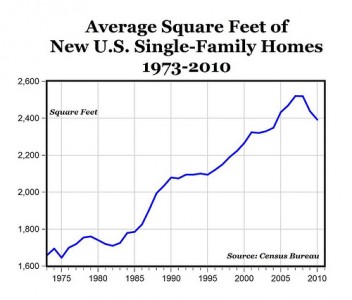What’s the big deal with living small?
Published on: Thursday, June 4th, 2015
A friend of mine in Denver, CO is breaking into new territory (news video) by creating a micro community in the residential rental market. And it’s a big deal, especially considering how small these things are.
By now probably everyone has heard about micro housing, living small, wee-houses and the like. It’s a phenomena of mostly younger generations opting out of big living quarters in favor of small, some might even say dinky, places to live. Some of the speculation is that it’s a natural consequence of higher youth unemployment coupled with that same group having higher student loan debt. Or maybe it is actually for the purely altruistic reasons that are often espoused by the adherents. Doesn’t matter, it’s what’s happening.
As we move along recent history’s timeline, starting back around 1968 the house has been the American’s version of peacock feathers. In his book Spent: Sex, Evolution and Consumer Behavior Geoffrey Miller goes over some of our primal motivators for our behavior, amongst them size. Size matters. It’s built into our cognitive biases and houses have been a readily available way of showing off how suited we are for…well, the book tells it better. Another theory that would work in conjunction with this idea is that since Equal Housing took effect there have been fewer ways to distinguish ourselves amongst our peers. Before 1968 people would live in ethnic neighborhoods where the wealthy and the poor lived next to each other, and individuals gained status by contributing to their community.
However in the recent past, with ethnic communities less common, the way to display dominance has been purchasing a large home. It has been our statement to the world that we’ve made it. Bigger was necessarily better (think Chevy Tahoe.) everyone wanted a McMansion. Then the Great Recession changed things a little bit.
A recession forces people to rethink their conditions. In this case smaller meant better, but not in the traditional way. It ended up being far more affordable to have a small home, and with limited access to cash, that became an only alternative for new home construction. The acquisition price is so low that mortgages aren’t all that necessary, utility costs are far less, material goods are fewer (because they don’t fit), and the cost of getting to work is usually less. Living became affordable and it seems to be attractive to a certain swath of the population. And something important has happened.
Mini houses, or micro-living has sticking power. It’s actually cool and trendy which means it could happen that people won’t necessarily judge you by the square footage you rattle off proudly or the neighborhood you live in. It won’t be the novelty of this trend that keeps it going, if that were the case then it might be considered as having been a fad after a few more years. But, we’re years into this. I’ve noticed more manufacturers of small homes like the ones that are on industrial trailers and dome homes. And other projects like shipping container communities and these micro apartments. And the reason it’s sticking is because of the benefits and the amenities this kind of living provides.
You’re closer to the action like bars, theatres, busy parks, dog parks, biking trails, & shopping centers. It’s the hussle and bussle of city living that for whatever reason people are drawn to and at a total cost of less than living elsewhere. Sure your cost per square foot skyrockets, but who cares if there’s more scarce greenback in the bank to spend with your friends traveling and doing the things that high-density living provides.
So now Denver, one of the coolest place to live (I did) has one of the coolest types of places to live. I think micro living is gaining speed and helping people prioritize exactly what it means to live life large, ironically.





